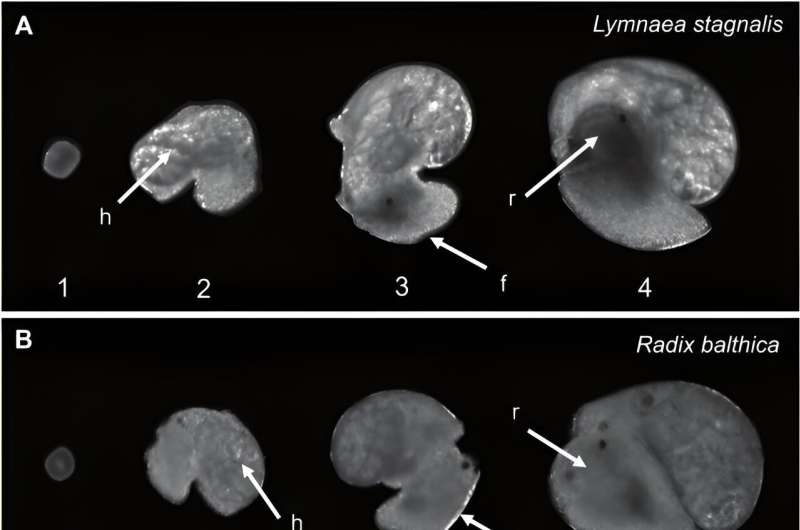This article has been reviewed according to Science X's editorial process and policies. Editors have highlighted the following attributes while ensuring the content's credibility:
fact-checked
peer-reviewed publication
trusted source
proofread
Video technology could transform how scientists monitor changes in species evolution and development

Scientists have made a major breakthrough in the study of species evolution, and provided further evidence that state-of-the-art visual technology can be used to track the tiniest changes in different organisms' development.
New research used a combination of robotic video microscopes and computer vision to measure all of the observable characteristics of embryos of three different species.
These measurements were recorded as spectra of energy and, through this, scientists were able to compare shifts between species alongside previously documented differences in the timing of discrete developmental events.
A detailed analysis of these so-called Energy Proxy Traits (EPTs) has provided researchers with the first evidence that traditionally measured timings of developmental events are associated with far broader changes to the full set of an embryo's observable characteristics.
They also found huge changes in an embryo's observable characteristics before and after the onset of each developmental event.
Writing in Frontiers in Physiology, the study's authors say that applying lessons from the research has the potential to advance how development and evolution is studied, by enabling greater depth in the assessment of biological development and the ability to combine data across a wide range of species.
This is something, they add, that is particularly crucial at a time when climate and other environmental changes are having a significant—and in many cases harmful—impact on many parts of the natural world.
The study was led by scientists from the University of Plymouth's EmbryoPhenomics Research Group, in the School of Biological and Marine Sciences, and builds on its 15-plus years of groundbreaking research into ways of monitoring embryo development.
Dr. Jamie McCoy, a postdoctoral researcher and the study's lead author, said, "The advances highlighted in this paper are critical to addressing the fundamental question of how species differ in the way that they develop. Measuring differences in the timings of development is one of the main ways in which researchers investigate how changes in development may drive evolution."
"But the results from our study suggest that measuring the timings of developmental events is just the tip of the iceberg in terms of how we measure and analyze evolutionary changes. By assessing EPTs across three different species, we have seen how they could provide us with an alternative approach to understanding how development leads to evolutionary change."
The EPT method uses timelapse video of animals during their earliest and most dynamic life stages.
Each video is composed of a series of individual pixels, whose brightness fluctuates from one frame to the next as objects—such as a beating heart, muscle contractions, or spinning of the whole embryo driven by tiny hairs—move.
Researchers can exploit these fluctuations in pixel values and convert them into frequency data, allowing them to track a huge breadth of different aspects of the biology of the animal as it develops.
The resulting visuals mean that rather than choosing individual parts of the animal to measure, scientists can capture all of its traits—such as changes in heart rate or movement—and interrogate the resulting frequency data to capture a greater breadth of its biological response.
Dr. Oliver Tills, senior author on the study, has been pioneering studies into embryo phenomics since 2007 and was in 2020 awarded a UK Research and Innovation Future Leaders Fellowship to advance his work.
He added, "Our current understanding of biology is limited by the technologies available to observe it, and we need a new technology-enabled approach to understanding the most complex period of an organism's life history. This study has broad implications for advancing our understanding of the nexus between biological development and evolution, and marks a significant step forward in how we might monitor the development of lifeforms all over our planet."
Two decades of expertise in developmental biology
The EPT method used in the current study builds on pioneering work started almost 20 years ago using manual measurements.
That work was led by Dr. Jennifer Smirthwaite and colleagues at the University of Plymouth and the Technical University of Munich, and documented a number of heterochronies—changes in the timings of developmental events between species—in a number of species of freshwater snail.
EPTs were applied to three species of freshwater snail from that study, and aimed to understand whether these evolutionary changes in the timings of development were associated with more high-dimensional changes to the phenotype.
More information: Jamie McCoy at al, Comparative phenomics: a new approach to study heterochrony, Frontiers in Physiology (2023). DOI: 10.3389/fphys.2023.1237022. www.frontiersin.org/articles/1 … ys.2023.1237022/full
Journal information: Frontiers in Physiology
Provided by University of Plymouth





















